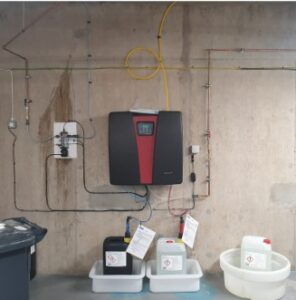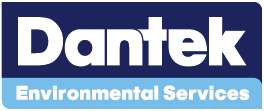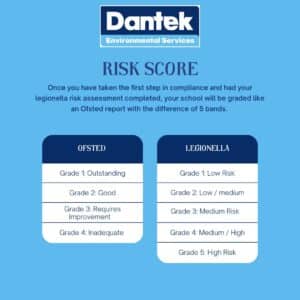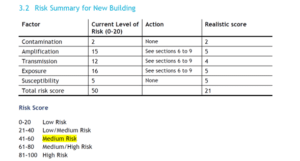Introducing Chlorine Dioxide
Water Systems in Sports Facilities: Introducing Chlorine dioxide
Introduction Chlorine dioxide:
 As experts in water hygiene and Legionella risk management, Dantek provides effective solutions for maintaining clean and safe water systems in sports facilities. In the sports industry, controlling Legionella in water systems is crucial to protect the health and well-being of athletes, staff, and visitors. While temperature control is often the primary method, situations may arise where it is not feasible to control the risk with this method. In these situations, Chlorine dioxide is a highly effective means of control that can be used to make water systems safe to use once again.
As experts in water hygiene and Legionella risk management, Dantek provides effective solutions for maintaining clean and safe water systems in sports facilities. In the sports industry, controlling Legionella in water systems is crucial to protect the health and well-being of athletes, staff, and visitors. While temperature control is often the primary method, situations may arise where it is not feasible to control the risk with this method. In these situations, Chlorine dioxide is a highly effective means of control that can be used to make water systems safe to use once again.
The Importance of Chlorine Dioxide Dosage:
Chlorine dioxide dosage has proven to be an extremely effective tool in combating Legionella growth and ensuring water system safety. It eliminates Legionella bacteria, prevents their multiplication, and minimizes the risk of Legionnaires’ disease transmission. In cases where temperature control is challenging or not an option, chlorine dioxide dosage provides a practical and effective solution. In addition to its bactericidal properties it also possesses the capability to remove biofilm. Biofilm is a slimy layer formed by microorganisms that can attach to the inner surfaces of pipes, tanks, and other components within water systems. It provides a protective environment for Legionella bacteria to thrive and multiply, making biofilm control crucial in Legionella management.
Important Considerations for Legionella Control:
Before installing a unit, it is crucial to conduct a comprehensive review of the water risk assessment and the existing control regime. This review helps identify potential areas of concern and determines the appropriate dosage requirements for effective Legionella control. In cases where control is lost, certain initial steps should be taken, such as reviewing the number and locations of samples taken and assessing the percentage of failures in the sampling process. It is particularly important to focus on water systems where the treatment regime, including factors like temperature and disinfectant concentrations, is not consistently achieving the desired control levels. Alongside the thorough review of the system and treatment regimes, frequent testing should be carried out, ideally on a weekly basis, to provide early warning signs of control loss. Once the system is successfully brought back under control, as evidenced by monitoring results, it is advisable to reassess the frequency of testing.
Implementing Regular Legionella Testing:
While chlorine dioxide dosage is an effective control measure, it should be complemented with regular legionella testing. Legionella testing serves as an interim safety check until a viable control solution, such as chlorine dioxide dosage, is fully implemented. Regular testing helps monitor the effectiveness of the control measures and ensures the ongoing safety of the water system.
Proven Effectiveness in Legionella Control:
Chlorine dioxide dosage has established itself as a highly effective solution for controlling Legionella in domestic water systems. Its implementation significantly reduces the risk of Legionella contamination, providing reassurance to facility owners and operators.
The benefits of using for Legionella control are numerous:
- Reduced Chemical Handling Issues: Chlorine dioxide is derived from relatively safe precursor chemicals, such as CDA (Chlorine Dioxide Activator) and CDB (Chlorine Dioxide Base). These are weak solutions of acid and salt, making them easy to handle and minimizing chemical handling concerns.
- Enhanced Oxidative Power: Approximately 2.6 times the oxidative power of chlorine. This increased potency enables it to effectively kill Legionella bacteria within drinking water limits.
- Biofilm Removal: Has the ability to remove biofilm, a slimy layer that provides a habitat for Legionella bacteria. By eliminating biofilm, chlorine dioxide disrupts the conditions conducive to Legionella growth, further enhancing the efficacy of Legionella control measures.
- On-Site Testing and Safety Verification: It is easy to test for on-site. This enables swift verification of safety through a simple on-site test, providing timely feedback on the effectiveness of Legionella control efforts.
- Compliance with Standards: The chemicals used for generation, CDA and CDB, comply with BS EN 1278 standards. This compliance ensures that effective levels of chlorine dioxide can be continuously dosed into drinking water supplies, meeting the necessary regulatory requirements.
- Low Ongoing Chemical Costs: CDA and CDB efficiently treat a large volume of water, resulting in cost-effective Legionella control. This helps minimize ongoing chemical expenses associated with maintaining water system safety.
- High-Quality Equipment Installation: Dantek provides chlorine dioxide solutions and installs top-of-the-range equipment to ensure the generation of the purest chlorine dioxide. This minimizes the production of by-products like chlorite and chlorate, further enhancing the safety and quality of the treated water.
By leveraging these benefits, chlorine dioxide dosage proves to be a reliable and efficient approach to Legionella control, offering peace of mind to those responsible for the safety of water systems.
Flexible Application:
Dosage can be applied in various water system configurations, making it adaptable to different sports facility settings. Whether it is a small training center or a large stadium, chlorine dioxide dosage can be tailored to suit specific requirements.
Continuous Protection:
Once the dosage is implemented, it provides continuous protection against Legionella growth. By regularly dosing the water system with chlorine dioxide, the risk of Legionella multiplication is effectively minimized, ensuring a safer water supply for athletes and visitors.
System Overview and Installation:
Dantek specializes in the installation of chlorine dioxide units specifically designed to address problematic systems that have tested positive for Legionella. Our units are meticulously engineered to generate automatically, providing a reliable and uninterrupted disinfection process.
To ensure maximum effectiveness, our team of experts conducts a comprehensive site survey, carefully assessing the specific requirements of each installation. This survey helps determine the optimal location for the unit, taking into account factors such as water flow, system design, and accessibility.
We understand that every water system is unique, which is why we offer customizable installation options. These options include integrating pulsed water meters, delayed action ball valves, or CLO2 aqua cells. By incorporating these components, we enable precise dosage control, ensuring the accurate and uniform dispersion throughout the water volume. This meticulous control over chemical dosage enhances the overall efficiency of the disinfection process.
We recognize the importance of correctly sizing the system and understanding the limitations of an installation. This is an area where other contractors often fall short. At Dantek, we prioritize accurate system sizing, ensuring that the unit is appropriately matched to the specific requirements of the water system. By doing so, we maximize the effectiveness of the installation and provide our clients with a solution tailored to their needs.
With our expertise and attention to detail, Dantek delivers reliable and efficient chlorine dioxide installations, addressing Legionella concerns effectively and preventing future occurrences.
Compliance and Safety Measures:
Dantek is dedicated to upholding regulatory guidelines and industry best practices, prioritizing the safety and compliance of our installations. Our proposed system strictly aligns with the recommendations set forth by the Drinking Water Inspectorate (DWI), guaranteeing continuous monitoring of chlorine dioxide levels to remain below the maximum allowable limit.
To ensure the safety and accuracy of the dosage, our system incorporates reliable measuring cells that prevent overdosage. These high-quality measuring cells provide precise and real-time monitoring, allowing for immediate adjustments if necessary. By implementing this safety cut-off system, we prioritize the well-being of both the water system and its users. We handle all aspects of the installation process, providing the necessary materials and skilled labour to ensure a hassle-free experience for our clients.
Rental Units:
To address immediate Legionella control issues, Dantek offers rental chlorine dioxide units that can be swiftly deployed to your sports facility. Renting eliminates the need for significant upfront capital expenses associated with purchasing and installing new equipment, allowing you to allocate your resources more efficiently while benefiting from effective Legionella control measures. Our rental units are designed to achieve and maintain legislative compliance, creating a safe and compliant environment for athletes and visitors. Additionally, chlorine dioxide treatment can lead to reduced running costs, and our rental units generate the highest purity for maximum effectiveness.
By implementing chlorine dioxide dosage as an effective Legionella control measure, sports facilities can ensure clean and safe water systems for athletes, staff, and visitors. Dantek’s expertise in water hygiene and Legionella risk management, along with our tailored solutions and rental units, enables us to support the sports industry in maintaining Legionella-free water systems. Contact our team to learn more and safeguard the health and well-being of everyone in your sports facility.
To learn more about chlorine dioxide units and how they can benefit your facility, contact us today https://www.dantekenvironmental.co.uk/contact-us/ at 01454 417 920 or email sales@dantek.co.uk.
Additional information can be found https://www.hse.gov.uk/pubns/priced/hsg274part2.pdf


 Top 5 problems with legionella risk assessments!
Top 5 problems with legionella risk assessments!



 Contact us for more information or to book a free demonstration.
Contact us for more information or to book a free demonstration. Our website is a great tool for local services, FAQs, sectors, and price guides. please visit
Our website is a great tool for local services, FAQs, sectors, and price guides. please visit